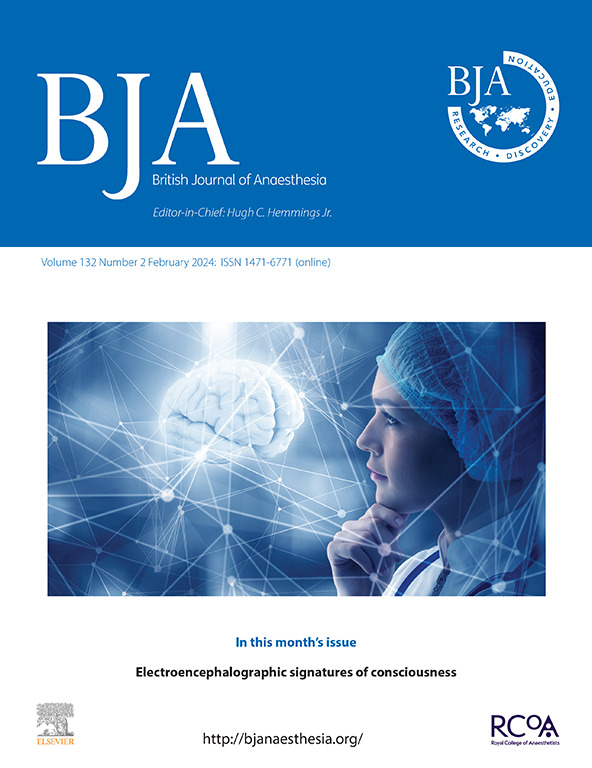快速通道髋关节和膝关节置换术后非贫血性缺铁与术后预后的关系:一项前瞻性队列研究
IF 9.1
1区 医学
Q1 ANESTHESIOLOGY
引用次数: 0
摘要
背景:术前缺铁性贫血是术后不良预后的常见危险因素。然而,术前无贫血缺铁对髋关节和膝关节置换术后预后的影响尚不确定。方法:我们使用来自丹麦8个部门的快速通道髋关节和膝关节置换术中心数据库注册进行这项前瞻性队列研究。贫血和缺铁的定义为2天的血红蛋白、30天的再入院率和90天的自我健康评估(EuroQol视觉模拟量表[EQ-VAS])。结果该队列包括964例缺铁患者和3919例缺铁患者,他们接受了原发性单侧髋关节或膝关节置换术。两组DAH30的中位数为29.0(四分位数范围29.0 ~ 30.0)天,但分布差异较大(P<0.001)。中位DAH校正差为-0.00(95%置信区间-0.00 ~ -0.00;P=0.001)和-0.00(95%置信区间-0.00至-0.00;P=0.006) d,分别为DAH30和DAH90。缺铁和其他终点之间没有关联。结论:铁缺乏对快速通道髋关节或膝关节置换术后30天和90天存活天数和在家天数的影响具有统计学意义,但临床意义不大。在这些手术中,术前纠正无贫血缺铁不太可能改善常见的术后结果。临床试验注册号:nct05613439。本文章由计算机程序翻译,如有差异,请以英文原文为准。
Association of non-anaemic iron deficiency with postoperative outcomes after fast-track hip and knee arthroplasty: a prospective cohort study.
BACKGROUND
Preoperative iron deficiency anaemia is a common risk factor for worse postoperative outcomes. However, the influence of preoperative iron deficiency without anaemia on postoperative outcomes after hip and knee arthroplasty is uncertain.
METHODS
We used the Fast-track Center for Hip and Knee Replacement Database registry from eight Danish departments for this prospective cohort study. Anaemia and iron deficiency were defined as haemoglobin of <130 g L-1 and transferrin saturation <20%, respectively. Patient characteristics were collected using patient-reported questionnaires and information on prescribed medication, laboratory results and follow-up using electronic healthcare records. Quantile regression was used to analyse changes in median days alive and at home at postoperative day 30 (DAH30) and day 90 (DAH90), adjusting for procedure, hospital, and comorbidity. Additional endpoints included length of hospital stay >2 days, 30-day readmission rate, and self-evaluated health (EuroQol Visual Analogue Scale [EQ-VAS]) at 90 days.
RESULTS
The cohort included 964 iron deficient and 3919 iron replete participants undergoing primary unilateral hip or knee arthroplasty. Median DAH30 was 29.0 (interquartile range 29.0-30.0) days in both groups, but differently distributed (P<0.001). Adjusted difference in median DAH was -0.00 (95% confidence interval -0.00 to -0.00; P=0.001) and -0.00 (95% confidence interval -0.00 to -0.00; P=0.006) days for DAH30 and DAH90, respectively. There was no association between iron deficiency and any of the other endpoints.
CONCLUSIONS
The influence of iron deficiency on days alive and at home at 30 and 90 days after fast-track hip or knee arthroplasty was statistically significant, but of minimal clinical importance. Correction of preoperative iron deficiency without anaemia is unlikely to improve common postoperative outcomes in these procedures.
CLINICAL TRIAL REGISTRATION
NCT05613439.
求助全文
通过发布文献求助,成功后即可免费获取论文全文。
去求助
来源期刊
CiteScore
13.50
自引率
7.10%
发文量
488
审稿时长
27 days
期刊介绍:
The British Journal of Anaesthesia (BJA) is a prestigious publication that covers a wide range of topics in anaesthesia, critical care medicine, pain medicine, and perioperative medicine. It aims to disseminate high-impact original research, spanning fundamental, translational, and clinical sciences, as well as clinical practice, technology, education, and training. Additionally, the journal features review articles, notable case reports, correspondence, and special articles that appeal to a broader audience.
The BJA is proudly associated with The Royal College of Anaesthetists, The College of Anaesthesiologists of Ireland, and The Hong Kong College of Anaesthesiologists. This partnership provides members of these esteemed institutions with access to not only the BJA but also its sister publication, BJA Education. It is essential to note that both journals maintain their editorial independence.
Overall, the BJA offers a diverse and comprehensive platform for anaesthetists, critical care physicians, pain specialists, and perioperative medicine practitioners to contribute and stay updated with the latest advancements in their respective fields.

 求助内容:
求助内容: 应助结果提醒方式:
应助结果提醒方式:


